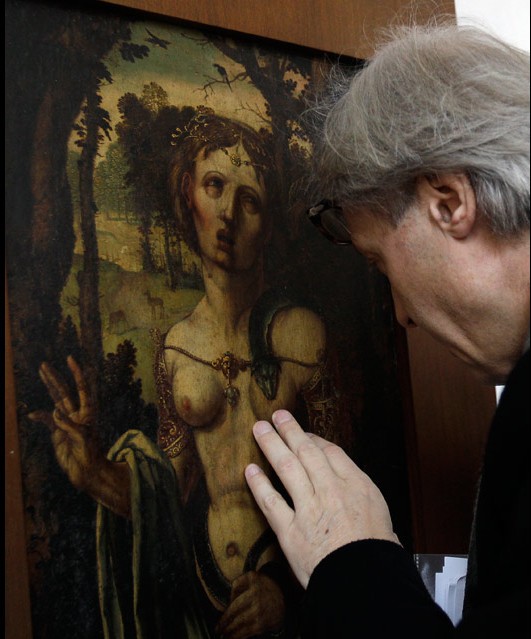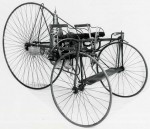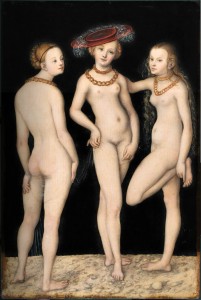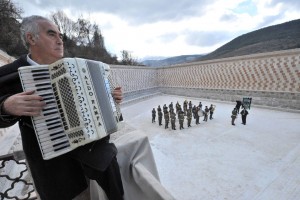 The Fountain of the 99 Spouts, a landmark 13th century fountain in the historic center of L’Aquila in the Abruzzo region of Italy, was reopened to the public on Thursday, the first historic monument to be fully restored after the earthquake that devastated the city on April 6, 2009. Under the leadership of the Italian Environmental Fund (FAI), various organizations public and private contributed funds to the €750,000 ($1 million) restoration.
The Fountain of the 99 Spouts, a landmark 13th century fountain in the historic center of L’Aquila in the Abruzzo region of Italy, was reopened to the public on Thursday, the first historic monument to be fully restored after the earthquake that devastated the city on April 6, 2009. Under the leadership of the Italian Environmental Fund (FAI), various organizations public and private contributed funds to the €750,000 ($1 million) restoration.
Although at first the fountain’s unique trapezoidal design and 93 stone faces spouting water seemed not to have been severely damaged in the earthquake, upon closer inspection it was found to have severe structural problems from leaking water conduits, a weakened floor and cracked walls. Once those immediate issues were seen to, restorers focused on the decorative elements, repairing the masks, the floral-motif separator stones, and cleaning the lichens and stains from the tanks and marble cladding.
Meanwhile, rubble still peppers the historic center, and the basilica of Santa Maria di Collemaggio which overlooks the fountain and shares its red and white marble color scheme is still roofless and held together by steel beams and giant braces. So sure, it’s a small first step towards recovery, but a significant one nonetheless because the fountain is inextricably linked to the founding of the city.
L’Aquila was founded by Frederick II, “Stupor Mundi,” Holy Roman Emperor, King of Jerusalem, King of Germany, of Italy, of Burgundy and Sicily, as a city-on-a-hill counterpart to the corrupt decay of Rome and geopolitical bulwark against the power of the papacy, Frederick’s greatest enemy in Italy. According to legend, the people from 99 castles (meaning not just the buildings but the mini-towns inside and around them) in the Aquilan Valley closed up shop and moved to L’Aquila. Each castle built its own piazza with a church and houses in the city to accommodate the new citizens.
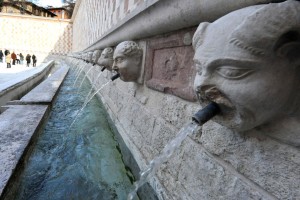 Frederick’s son Conrad IV finished building the city in 1254 after his father’s death, only to have it destroyed by his half-brother Manfred just 5 years later. King of Sicily Charles I of Anjou rebuilt it shortly thereafter, and the Fountain of the 99 Spouts was completed in 1272. It wasn’t called the Fountain of the 99 Spouts then, probably because there weren’t 99 spouts. It was called the Fountain of the Rivera after the central neighborhood adjacent to the river Aterno in which it was built. The 93 spouts sprang from stone faces, each one different, representing figures from mythology, animals, monks, knights, and more. There are another 6 spouts perched against a flat wall on the side of the piazza, but those were probably added later to make the fountain match the foundational legend.
Frederick’s son Conrad IV finished building the city in 1254 after his father’s death, only to have it destroyed by his half-brother Manfred just 5 years later. King of Sicily Charles I of Anjou rebuilt it shortly thereafter, and the Fountain of the 99 Spouts was completed in 1272. It wasn’t called the Fountain of the 99 Spouts then, probably because there weren’t 99 spouts. It was called the Fountain of the Rivera after the central neighborhood adjacent to the river Aterno in which it was built. The 93 spouts sprang from stone faces, each one different, representing figures from mythology, animals, monks, knights, and more. There are another 6 spouts perched against a flat wall on the side of the piazza, but those were probably added later to make the fountain match the foundational legend.
The striking red and white checkerboard walls made from marble quarried at Genzano di Sassi like the facade of Santa Maria di Collemaggio were added probably in the 15th century. The wide basins underneath the spouts were added in 1578 so that townspeople could do their laundry and then spread it out on the wide, shallow staircases to dry in the whitening power of the sun. In 1657, gripped by a plague that killed 40% of the population, the city put four huge boilers in the middle of the square so all laundry could be sterilized.
There are also mysteries surrounding this fountain. For instance, the source of it is unknown. The Rivera neighborhood was said to have a spring that was a perpetual source of clean water, but over the centuries of construction, the spring has been lost. Now legend has it that the architect of the fountain, Tancredi di Pentima, is buried in the middle of the piazza under the largest stone after having been executed for refusing to divulge the location of the spring or for offering to divulge the location of the spring, nobody knows which.
